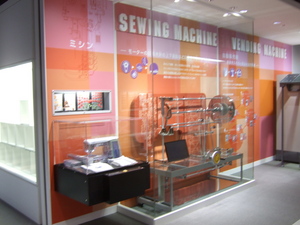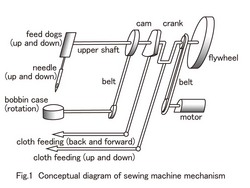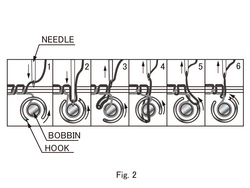Nagoya City Science Museum
TOP > Exhibition Guide > Keyword Search > Starting with "N" > needle > Sewing Machine
Sewing Machine

Purpose of Exhibition
Sewing machines, which can sew and stitch leather and fabric with a thread, is a familiar machine to many. The English name is "Sewing machine" and is the origin of the pronunciation "mishin" in Japanese. Some movements, such as the vertical needle movement, rotating movement of twisting thread around small a metal tank (bobbin case) and movement of feeding gears, pushing fabric forward to the next position, are all linked. The purpose of this exhibition is to help you understand how these complicated movements occur.


Additional Knowledge
[Lower Shaft and Upper Shaft]
The machine is powered by electric motors.
Rotation of the motor transmits the flywheel through the belt on the right side. The flywheel is to maintain constant rotation as much as possible. Rotation of the flywheel is transmitted to the upper shaft inside the sewing machine. Through links and vertical movement of feed dogs and cranks, it is converted into the vertical movement of the needle. The function of the feed dogs is to provide needle thread for stiches when required (Figure 1).
Furthermore, the rotation of the upper shaft is transmitted to the lower shafts through the belt cam and crank. Rotation of the lower shaft leads to the following two functions: the first one is the rotating movement of the small metal tank, "bobbin case" (twice the speed of the upper shaft), and following is the gear feeding of the fabric vertical and horizontal movement. A sewing machine is a machine that converts a motor rotation into four these types of movements.
[Needles]
The needle of a sewing machine, after being shaped like a needle, goes through a thermal process called "hardening". Through this process strong needles are produced. Unlike hand sewing needles, the hole near the tip has been drilled. The upper thread passes through the needle here and sews the fabric.
[Small Metal Tank (Bobbin Case)]
When the needle penetrates the fabric, the upper thread is drawn into the back side of the fabric. However, when the needle is pulled out of the fabric and return to the front of the fabric, the upper thread makes a loop in the back side of the fabric because of the frictional force of the upper thread and the fabric.
At this time, due to the rotation of the small metal tank (bobbin case), the lower thread passes through the upper lower thread in loop state (Figure 2). This is how strong stitches are made. The repetition of this work is sewing.
[From Sewing to Embroidery]
In order to do complex embroidery stitches, it requires a skilled sewing machine operator. However, by digitalizing some sample data, machine embroidering has become easy for unskilled workers. It was the birth of computer embroidery.
[The history of the sewing machine]
Similar to the current structure of the sewing machine, the machine with a hole on the tip of the needle where the upper thread passes through was invented at the beginning of the 1930s. However, because the inventor, Walter Hunt, did not get a patent it caused patent disputes between multiple companies.
An American, Elias Howe, invented a shuttle and a bobbin. By combining the timing of needle and thread, he invented the machine source of today's machines. It was patented in 1846. Although he had the patent for the structure of the "final stitching", he did not commercialize it. He received huge royalties filling lawsuits against Singer, which started sales of sewing machines with similar structures.
An American, Isaac Merritt Singer, invented a sewing machine, moving the middle tank by the power of a driver moved by the crank pin reaching the lower shaft under the table. Singer got the patent in 1851, and pursued the marketing rights and the acquisition of the manufacturing know-how. Singer Sewing Machine Company eventually became popular with American households and continued spreading worldwide. Singer corporation predicted that fashion demand would shift from a privileged class of people to the average citizen, and introduced a system of selling sewing machines on a monthly based payment. Singer became the world's largest sewing machine manufacturer company.
When was the sewing machine introduced to Japan? There is an old record showing that Perry sent a sewing machine to the Shogun when Perry came to Japan for the second time. Later, John Manjiro brought back a sewing machine to Japan from the United States in 1860. It is also said that the first person who operated a sewing machine was a "Tenshouin Atsuhime"When the sewing machine had become popular during the Meiji Period, they were first imported. With the technical skills acquired through repairs, domestic production started. The first manufacturer was Saguchi Tetsuzo who was a gun maker until the Edo period. The first domestic sewing machine was exhibited at the second National Industrial Exhibition, which was held in Tokyo in 1881. With the spread of western clothing, sewing machines also spread.
Cooperation: Brother Industries, Ltd.
Article by Koichi Mabuchi, curator
